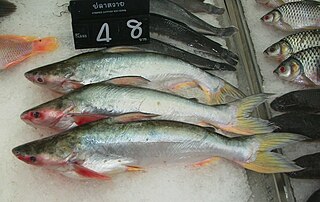
The iridescent shark,iridescent shark catfish is a species of shark catfish native to the rivers of Southeast Asia. Despite its name, it is not a shark. It is found in the Mekong basin as well as the Chao Phraya River, and is heavily cultivated for food there.

Clarias is a genus of catfishes of the family Clariidae, the airbreathing catfishes. The name is derived from the Greek chlaros, which means lively, in reference to the ability of the fish to live for a long time out of water.

Basa is a species of catfish in the family Pangasiidae. Basa are native to the Mekong and Chao Phraya basins in Mainland Southeast Asia. These fish are important as a food source, and also on the international market. They are often labelled in North America and Australia as "basa fish", "swai", or "bocourti". In the UK all species of Pangasius may legally be described as "river cobbler", "cobbler", "basa", "pangasius", "panga", or any of these with the addition of "catfish". In the rest of Europe, these fish are commonly marketed as "pangasius" or "panga". In Asian markets, names for basa include "Pacific dory" and "patin". Other related shark catfish may occasionally be incorrectly labeled as basa fish, including P. hypophthalmus and P. pangasius.

Pangasianodon is a genus of large to very large shark catfishes native to the Mekong and Chao Phraya Rivers in Southeast Asia and adjacent China.

Leptobarbus is a genus of cyprinid fish that are native to freshwater habitats in Southeast Asia. They are important food fish. It is the only genus in the subfamily Leptobarbinae. Leptobarbus hoevenii or "sultan fish" migrate the fresh water rivers of Malaysia and travel at the surface in schools of 40-80 individuals at speeds of 0.48-1.08 km. Acid-soluble collagen (ASC) and pepsin-soluble collagen (PSC) were extracted from the muscles of selected cultured catfish, red tilapia, black tilapia, pangasius catfish, sultan fish and labyrinth fish, freshwater fishes that are widely consumed in Malaysia. The extracted yields for the tested species were higher for PSC as compared with ASC.

Hemibagrus is a genus of catfishes of the family Bagridae.
Hypophthalmus is a genus of long-whiskered catfishes native to freshwater in tropical and subtropical South America.
Parakysis is a genus of catfishes of the family Akysidae. It includes six species.
Pseudobagarius is a genus of catfishes of the family Akysidae.

Pangasius pangasius, the Pangas catfish, is a species of shark catfish native to fresh and brackish waters of Bangladesh, India, Myanmar, and Pakistan. It has also been introduced to Cambodia and Vietnam. This species grows to a standard length of 3 metres (9.8 ft). This species South Asia, the other being P. silasi from the Krishna River.

The giant pangasius, paroon shark, pangasid-catfish or Chao Phraya giant catfish is a species of freshwater fish in the shark catfish family (Pangasiidae) of order Siluriformes, found in the Chao Phraya and Mekong basins in Indochina. Its populations have declined drastically, mainly due to overfishing, and it is now considered Critically Endangered.
Ompok is a genus of fish in the family Siluridae found in lakes and large rivers throughout South and Southeast Asia.
Cuulong Fish JSC is a fishery company in Vietnam, specializing in farming and processing two species of pangasius, a genus of catfish, Pangasius bocourti and Pangasius hypophthalmus. The company's main facilities are in Long Xuyen City in An Giang Province, adjacent to the Mekong River. Cuulong processes over 80,000 tons of pangasius per year. Products include frozen fillets, breaded fillets, fishsticks, nuggets and fish sausage. Cuulong Fish's stock is listed at the Ho Chi Minh Securities Trading Center.
Panga is the common South African name for Pterogymnus laniarius, a small, ocean-dwelling fish.
Pseudolais is a genus of shark catfishes native to Southeast Asia.
Pangasius kinabatanganensis is a species of shark catfish. It is a freshwater, benthopelagic and tropical fish, measuring up to 23.8 centimetres (0.78 ft) long. It is found in the Kinabatangan basin, in northeastern Borneo which is in the state of Sabah, Malaysia.
Pangasius conchophilus is a species of shark catfish. It is a freshwater, benthopelagic, potamodromous and tropical fish, measuring up to 120 centimetres (3.9 ft) long. It is found in the Mekong, Bangpakong, and Chao Phraya basins.
Pangasius myanmar is a species of shark catfish. It is a freshwater, benthopelagic, tropical fish, measuring up to 120 centimetres (3.9 ft) long. It is found from Irrawaddy to Salween and in Rangoon.









